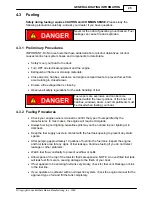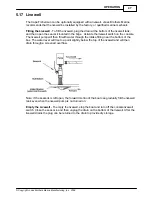
OPERATION
33
© Copyright Jones Brothers Marine Manufacturing, Inc. 2008
Acceleration at FULL throttle is not recommended
before the engine break-in period has been
completed, and the first engine check-up
performed. For information about the break-in
period, please examine the engine owner's
manual. FULL throttle acceleration should not take
place until after this check-up.
5.3
Propeller
The condition of your propeller (prop) has a major influence on the performance of your
boat. Your engine is equipped with the best size prop for normal conditions. If you have
unusual use or weight conditions, a special prop may be required for altered applications.
Also, it is advisable to keep an extra prop on board. A damaged prop can affect your boat's
top speed, cause vibrations or a sudden drop in RPMs, or increase fuel consumption.
When replacing propellers, stay within the engine
manufacturer's maximum and minimum RPM
ranges. This information is in your engine manual.
Troubleshooting:
Cavitation occurs in all propeller driven boats under certain conditions. It is easily
recognized by sudden increases in RPMs (revving) or a sudden drop in speed. This
occurs when cavities or air pockets form around the prop, due to improper size or
damage to the propeller. Cavitation is influenced by prop design, speed, placement, and
even water temperature.
Ventilation, a similar problem, caused by air drawn in around the prop in a tight turn or
improper engine trim angle. In most cases, a change in the drive angle will correct the
problem. If either of these problems persist, you are advised to experiment with a
different size prop or contact your dealer.
5.4
Trim
The engines on all Cape Fisherman models are equipped with power tilt and trim
mechanisms. The purpose of the tilt is to raise the engine for launching, loading, or
trailering your boat.
Trim refers both to the weight distributions inside the boat and to the angle of thrust of the
drive unit. The angle of thrust from the engine either forces the bow up or down. An engine
tilted too far in (forward) will cause the bow to nose downward or "plow." A drive unit tilted
too far out (aft) will cause the bow to ride too high. Adjust the trim so that the angle of thrust
is parallel to the water at full throttle at a normal running attitude.
When the angle of thrust is too far out (aft), the engine noise may rise indicating that the
propeller is cavitating. Adjust the engine trim in (forward) to correct the problem. The boat
may also tend to "porpoise" or oscillate in maximum bow up position as well. This can be
corrected by adjusting the engine trim in to lower the bow.
For a smoother ride when running into heavy seas, the bow should be adjusted so that the
entry point into the water is slightly forward of the helm location. When running in a
following sea, the bow should be trimmed higher to prevent the boat from plowing into the
Содержание Cape Fisherman
Страница 1: ...Cape Fisherman Owner s Manual...
Страница 6: ......
Страница 7: ...WELCOME Part I...
Страница 9: ...OVERVIEW Part II...
Страница 12: ......
Страница 13: ...BOATING SAFETY Part III...
Страница 26: ......
Страница 27: ...GENERAL BOATING INFORMATION Part IV...
Страница 37: ...OPERATION Part V...
Страница 55: ...MAINTENANCE AND SERVICE Part VI...
Страница 61: ...WINTERIZATION AND STORAGE Part VII...
















































